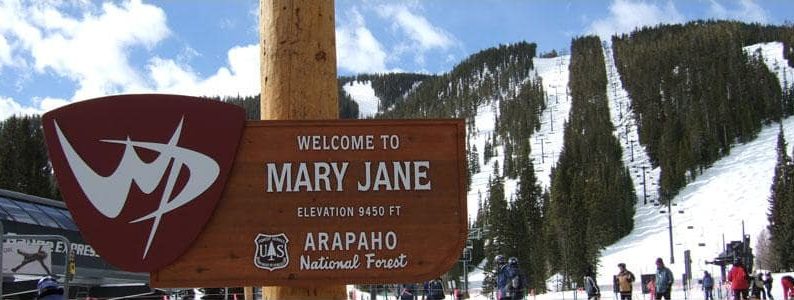
Winter Park has been home to Denverites looking to get rad for over 80 years. Nestled in Fraser Valley just north of Berthoud Pass lies 3,000 acres of some of the most iconic terrain offered in Colorado. The town is located at 9,000 feet and is home to a mountain that has seen many changes throughout its operation. The mountain boasts seven territories to meet the needs of any skier or rider. Having skied this mountain myself every season for nearly 20 years, there is a vibe in this town that is unmatched.
The valley area was home to Arapahoe and Ute Indians and was discovered by pioneers in 1820, where it was then settled in 1850 for mining and logging. Winter Park proper was settled in 1923 when it was used as a construction camp for the Moffat Tunnel, named after David Moffat, who pioneered the rail line from Denver to the West Coast. The west portal of the tunnel lies at the mountain base area and was the original name of the ski area, West Portal. By the 1930s, skiers were using the train to access some of the man-made trails in West Portal. In 1938 a weekend ski train was commissioned to transport patrons to the West Portal, where the U.S. Forest Sevice allowed Denver to develop the area by putting in ski tows and trails. In 1940, under the direction of George E. Cranmer, the first ski tow was installed in West Portal. This was the official beginning of Winter Park as we know it today.

As skiing became more popular in the U.S., Winter Park began to expand terrain to meet the excitement of the locals. In 1940 the Denver-operated ski area, West Portal, only had three ski trails. The first named ski trail was named after Brian Hughes, a Denver attorney and passionate outdoorsman who died in a skiing accident at Loveland Pass on May 27, 1939. In 1950, the city of Denver could no longer operate the ski area, and a board of trustees was assembled for operation. Stephen Bradley developed the first snow grooming machine, the “Bradley Packer,” and developed ski trails all over the mountain. The trails he cut are known for being straight down the fall-line, aka steep. George Underwood developed lifts alongside these new trails, and when he retired in 1972, all the lifts operating at the time were built by George.

The man-made trails in West Portal developed in the ’30s were home to what is now the fabled bump runs of Mary Jane. This mountain, now part of Winter Park Resort, got its name from a woman who, ahem… met the needs of loggers and miners in the 1800s. Business was good for Mary Jane, and she acquired a plot of land now known as Mary Jane Placer. In the 1930s, the Colorado Arlberg Club, a club dedicated to promoting skiing, developed the first man-made ski trail in Colorado. The club aptly named it Mary Jane Trail, as it was developed on the same land once owned by Mary Jane. Winter Park was officially opened in 1940, but the Mary Jane remained separate from the Denver-operated ski area. The two areas merged in 1975, where 300 skiable acres expanded Winter Park’s terrain by 80%. Some of Colorado’s steepest terrain, The Chutes, was added in 1986, where the phrase “No Pain No Jane” got its namesake.

The Eagle Wind territory was added in 2006 and got its name from the Arapahoe tribe that inhabited the valley. The new area was developed in cooperation with members of the tribe, and on its opening day, a Northern Arapahoe blessing ceremony was performed to honor the tribe. Several names of trails in this area are named after Arapahoe leaders in the 1800s. It’s only fitting to honor the original inhabitants of this awe-inspiring mountain.
- Related: VIDEO: The Oldest Downhill Resort in Colorado, Monarch Mountain, Celebrates 80-Years this Year
The first major ski resort in Colorado is something to truly cherish and will always be the soul of Colorado skiing. The front range of the Continental Divide is known for easy access to world-class skiing, and they continue to adapt to meet the demands of skiers and riders. But the people in this town never forget what made this mountain.
